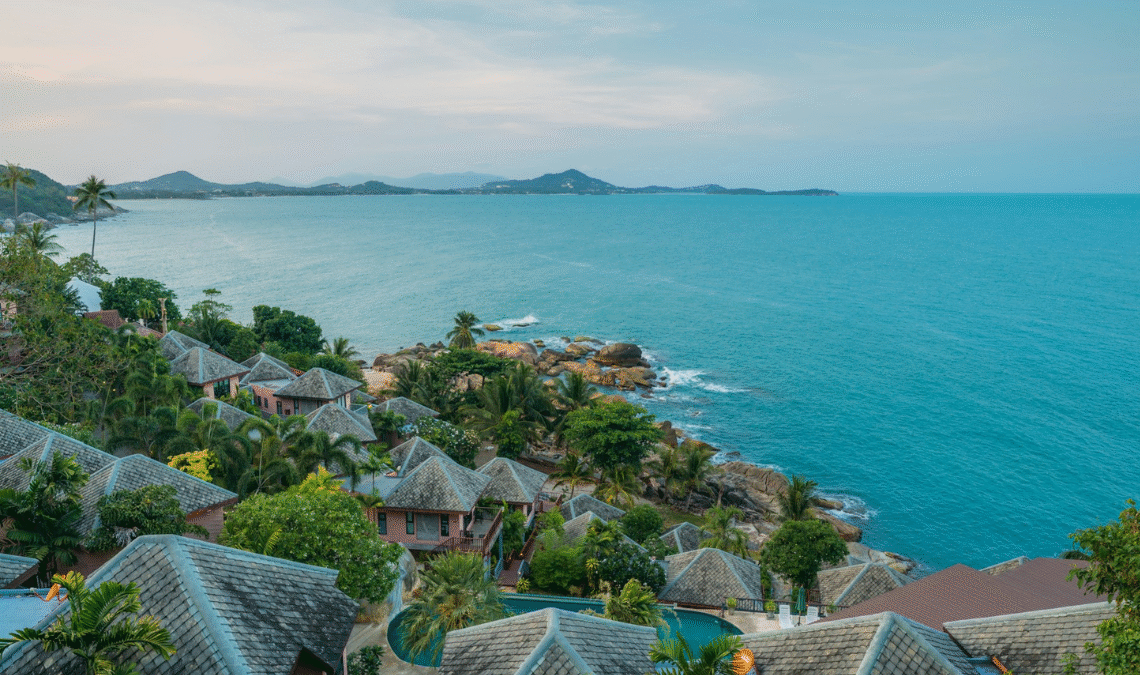“I love it”, is the response of a retired friend who sold his condo, car and moved to Bangkok. He likes the culture, food and the people. He lives on less than 2000 Canadian dollars per month in a nice two-bedroom condo in the city. He eats out more than he cooks because it’s so cheap and healthy. Thailand, known for its rich culture, diverse landscapes, and warm hospitality, offers a variety of experiences for travellers and expatriates alike.
Weather by Season and Specifically from December to April:
November to February (Cool Season): This period is considered the most pleasant time to visit Thailand. Temperatures are comfortable, ranging from 32°C to 36°C, and rainfall is minimal. The Sun
March to May (Hot Season): Temperatures rise significantly during these months, often exceeding 40°C, especially in inland areas. Coastal regions may experience slightly cooler temperatures due to sea breezes.
June to October (Rainy Season): Characterized by high humidity and frequent rainfall, this season can lead to travel disruptions, particularly in coastal and island regions.
National Language:
Thai is the official language of Thailand. While English is commonly understood in urban areas and tourist destinations, learning basic Thai phrases can enhance your experience and interactions with locals.
Religion:
Buddhism is the predominant religion, practiced by approximately 95% of the population. The country also hosts communities practicing Islam, Christianity, and Hinduism, reflecting its cultural diversity.
Women:
Thailand is known for its respectful and welcoming culture towards women. Gender equality is recognized, and women actively participate in various sectors, including business, politics, and education.
Vaccinations Required:
No specific vaccinations are mandatory for travellers from North America to Thailand. However, it’s advisable to ensure routine vaccinations, such as measles, mumps, rubella (MMR), diphtheria, tetanus, and influenza, are up to date. Additionally, considering vaccines for hepatitis A and B, typhoid, and Japanese encephalitis may be prudent, depending on your travel plans and activities.
Common Illnesses:
Travelers may encounter common ailments such as food and waterborne illnesses, respiratory infections, and mosquito-borne diseases like dengue fever. It’s advisable to practice regular hand hygiene, consume food from reputable sources, and use mosquito protection measures.
Crime Rate:
Thailand is generally considered safe for tourists. However, petty crimes like pickpocketing and scams can occur, especially in crowded areas and tourist hotspots. Exercise standard safety precautions, such as safeguarding personal belongings and being cautious of unsolicited assistance.thethailandlife.com
Food – National Dish/Type of Local Staple:
Thai cuisine is renowned for its bold flavours and variety. Staples include rice and noodles, complemented by dishes like “Pad Thai” (stir-fried noodles) and “Tom Yum Goong” (spicy shrimp soup). A national favourite is “Som Tum,” a spicy green papaya salad that combines sweet, sour, and spicy elements.
Cost of Living: Local Food, Foreign Imports:
Local Food: Eating at local markets and street vendors is both affordable and authentic. A typical meal can cost between $0.81. – $2.70 USD
Foreign Imports: Imported goods, including certain food items, are generally more expensive due to import taxes. Opting for local products is both economical and offers a more immersive cultural experience.
Accommodation – Rental, Airbnb, Costs:
Rental Costs: Accommodation prices vary by location and type. I
In Bangkok, a one-bedroom condo in central areas like Sukhumvit or Silom typically costs between $405-$1 080 USD per month.
In Chiang Mai, prices range from $216 – $405 USD per month.
Coastal cities like Phuket and Pattaya range from $270 – $945 USD per month.
Airbnb: Short-term rentals (less than 30 days) are subject to legal restrictions in Thailand. The Hotels Act requires properties rented for less than 30 days to have a hotel license, which most condominium buildings do not possess. Renting such properties without proper licensing is illegal and can lead to fines and other penalties. It’s advisable to seek accommodations with proper licensing or opt for rentals of 30 days or more to comply with local regulations.
Expats in Thailand tend to gravitate toward certain cities and regions based on factors like lifestyle preferences, cost of living, and availability of amenities. Here are some popular destinations for expats in Thailand:
1. Bangkok
The capital city is bustling with life, offering a vibrant mix of culture, business, shopping, and nightlife.
It’s home to international companies, modern infrastructure, and a wide range of services for expats.
Popular areas include Sukhumvit, Silom, and Sathorn, where you’ll find many restaurants, shops, and luxury apartments.
Lifestyle: Urban, busy, with plenty of work and entertainment options.
Cost of Living: Higher than in smaller cities, especially for accommodation and dining in expat-centric areas.
2. Chiang Mai
Known for its relaxed lifestyle, beautiful nature, and lower cost of living compared to Bangkok.
A popular destination for digital nomads and retirees.
Expats are drawn to the city’s strong sense of community and abundance of cafes, coworking spaces, and wellness centers.
Lifestyle: Quiet, relaxed, with a slower pace of life.
Cost of Living: Generally much lower than Bangkok, especially for accommodation and food.
3. Phuket
Thailand’s largest island, offering stunning beaches and a resort-style lifestyle.
Popular among retirees and expats looking for a blend of relaxation and access to modern amenities.
The area of Patong is particularly popular with those seeking more tourist-focused services.
Lifestyle: Coastal, laid-back, but with vibrant nightlife and plenty of luxury accommodations.
Cost of Living: Higher than Chiang Mai but can be lower than in Bangkok depending on the area.
4. Pattaya
Located on the coast, Pattaya is known for its beaches, entertainment, and expat-friendly atmosphere.
Popular with retirees and those who enjoy the proximity to both Thailand and Cambodia.
It offers a combination of a low-cost lifestyle with easy access to both modern amenities and vibrant nightlife.
Lifestyle: Beach-oriented with a mix of both quiet and lively areas.
Cost of Living: Generally affordable, especially for accommodation and dining.
5. Hua Hin
A small beach town that’s popular with retirees looking for a quieter, more peaceful lifestyle.
Home to a large expat community, particularly from Europe and North America.
Known for its proximity to golf courses, shopping malls, and a relaxed atmosphere.
Lifestyle: Quiet, and peaceful, with a focus on beach living and leisure activities.
Cost of Living: Affordable, similar to Chiang Mai, with reasonable accommodation and food prices.
6. Krabi
A more laid-back beach destination in southern Thailand, attracting expats who prefer natural beauty and a quieter lifestyle.
Known for its stunning limestone cliffs, crystal-clear waters, and small expat communities.
Lifestyle: Peaceful, nature-focused, with a small-town feel.
Cost of Living: Lower than Phuket, though accommodation in tourist-heavy areas can be pricey.
7. Koh Samui
A tropical paradise that offers a relaxed lifestyle with a well-established expat community.
Popular among retirees and entrepreneurs, especially those in the wellness and tourism industries.
Offers great beaches, yoga retreats, and opportunities for outdoor activities.
Lifestyle: Island living with a focus on health and wellness.
Cost of Living: Can be high in tourist areas, but affordable in quieter parts of the island.
8. Ayutthaya
A historical city just north of Bangkok that offers a more traditional Thai experience.
Expats here enjoy the rich culture, heritage sites, and proximity to the capital.
Lifestyle: Cultural, historical, quieter than the big cities.
Cost of Living: Generally affordable, with lower rental costs and a laid-back lifestyle.
Other Notable Locations:
Kanchanaburi: Popular for its natural beauty, waterfalls, and peaceful living.
Isaan Region (Northeast Thailand): Known for its traditional lifestyle, rural charm, and lower living costs.
Each of these destinations offers a different vibe, so expats in Thailand often choose based on their work situation, preferred pace of life, and proximity to amenities or nature.
Things to Do for Those Staying 3-4 Months:
An extended stay in Thailand offers numerous opportunities to immerse yourself in its culture and lifestyle:
Language Learning: Enroll in Thai language courses to enhance communication and cultural understanding.
Culinary Exploration: Participate in cooking classes to learn traditional Thai recipes and cooking techniques.
Cultural Festivals: Experience local festivals such as Songkran (Thai New Year) in April, celebrated with nationwide water fights and cultural ceremonies.
Volunteer Opportunities: Engage in community service or conservation projects to give back and connect with local communities.
Travel: Explore Thailand’s diverse regions, from the bustling streets of Bangkok to the tranquil beaches of the south and the mountainous terrains of the north.
Embracing Thailand’s rich cultural heritage, diverse cuisine, and warm community will undoubtedly make your extended stay both enjoyable and enriching.
Check out these related articles in the Snowbirding Series :
Snowbird Adventures:Perks of Wintering in Warmer Climates
Snowboarding Series: Costa Rica – Living the Pure Life
Snowboarding Series: Philippines
Sources: Home & Travel
thethailandlife.com






